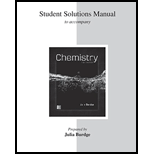
Concept explainers
Interpretation:
The given equations are to be completed and balanced.
Concept Introduction: A
Reactants are written in left side of chemical reaction and products are written in right side of chemical reaction
In a balanced equation, the number of atomsshould be equal on both sides of the reaction.
In the case of a nonbalanced equation, choose big number in front of each atom to do balance equation.
A chemical reaction consists of the atoms or molecules that combine with each other to give a product.
Answer to Problem 34QP
Solution: The complete and balanced equations are represented below:
(a)
(b)
(c)
(d)
(e)
(f)
Explanation of Solution
a)Sodium reacts with water
A colorless solution of potassium hydroxide is formed and hydrogen gas is evolved when sodium reacts vigorously with water. The dissolved hydroxide makes the resulting solution basic.
The reaction is as
b)An aqueous solution of
Sodium carbonateand water are obtained when sodium hydroxide reacts with carbon dioxide.
The reaction is as:
c)Solid
Sodium chloride
The reaction is as
d)Solid
Sodium chloride
The reaction is as
e)Solid
When solid sodium bicarbonate
The reaction is as
f)Solid
When solid sodium carbonate
The reaction is as:
Want to see more full solutions like this?
Chapter 23 Solutions
Student Solutions Manual for Chemistry
- What mass of CO2 is produced from the decomposition of 25.5 grams of NaHCO3?arrow_forwardWrite the balanced chemical equation for the reaction of dilute sulphuric acid with iron.arrow_forwardTreatment of cobalt(II) oxide with oxygen at high temperatures gives Co3O4. Write a balanced chemical equation for this reaction. What is the oxidation state of cobaltin Co3O4?arrow_forward
- What mass, in grams, of hydrogen gas forms during the complete reaction of 10.01 g of calcium with water?arrow_forwardThe amount of sodium hypochlorite in a bleach solution can be determined by using a given volume of bleach to oxidize excess iodide ion to iodine, because the reaction goes to completion. The amount of iodine produced is then determined by titration with sodium thiosulfate, Na2S2O3, which is oxidized to sodium tetrathionate, Na2S4O6. Potassium iodide was added in excess to 5.00 mL of bleach (density = 1.00 g/mL). This solution, containing the iodine released in the reaction, was titrated with 0.100 M Na2S2O3. If 34.6 mL of sodium thiosulfate was required to reach the endpoint (detected by disappearance of the blue color of the starch iodine complex), what was the mass percentage of NaClO in the bleach?arrow_forward
 Chemistry: Principles and ReactionsChemistryISBN:9781305079373Author:William L. Masterton, Cecile N. HurleyPublisher:Cengage Learning
Chemistry: Principles and ReactionsChemistryISBN:9781305079373Author:William L. Masterton, Cecile N. HurleyPublisher:Cengage Learning Chemical Principles in the LaboratoryChemistryISBN:9781305264434Author:Emil Slowinski, Wayne C. Wolsey, Robert RossiPublisher:Brooks Cole
Chemical Principles in the LaboratoryChemistryISBN:9781305264434Author:Emil Slowinski, Wayne C. Wolsey, Robert RossiPublisher:Brooks Cole Chemistry: Principles and PracticeChemistryISBN:9780534420123Author:Daniel L. Reger, Scott R. Goode, David W. Ball, Edward MercerPublisher:Cengage Learning
Chemistry: Principles and PracticeChemistryISBN:9780534420123Author:Daniel L. Reger, Scott R. Goode, David W. Ball, Edward MercerPublisher:Cengage Learning ChemistryChemistryISBN:9781305957404Author:Steven S. Zumdahl, Susan A. Zumdahl, Donald J. DeCostePublisher:Cengage Learning
ChemistryChemistryISBN:9781305957404Author:Steven S. Zumdahl, Susan A. Zumdahl, Donald J. DeCostePublisher:Cengage Learning
 Chemistry: An Atoms First ApproachChemistryISBN:9781305079243Author:Steven S. Zumdahl, Susan A. ZumdahlPublisher:Cengage Learning
Chemistry: An Atoms First ApproachChemistryISBN:9781305079243Author:Steven S. Zumdahl, Susan A. ZumdahlPublisher:Cengage Learning





